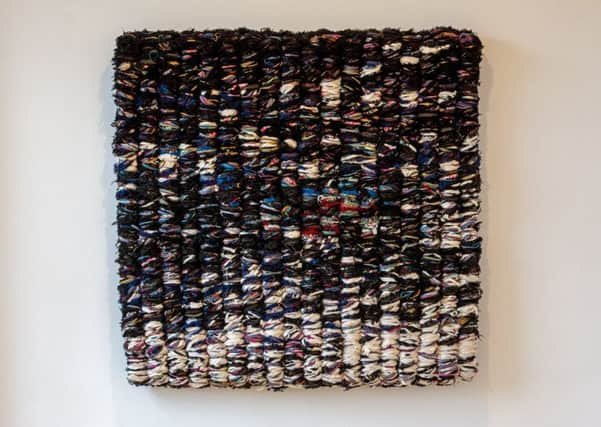Art reviews: The Cordis Prize | Anne-Marie Copestake | Arpita Shah


The Cordis Prize for Tapestry, Inverleith House, Edinburgh ***
Anne-Marie Copestake, Cooper Gallery, Dundee ***
Arpita Shah: Nalini, Street Level Photoworks, Glasgow ****
Seeing exhibitions at Inverleith House these days can feel like rubbing salt in a wound. Since the closure of the building as a permanent contemporary art space, occasional exhibitions are painful reminders of what we’ve lost. Nevertheless, it’s better to see the building in use than empty and shuttered, and the shortlisted
Advertisement
Hide AdAdvertisement
Hide Adworks for the Cordis Prize look superb in its well proportioned Georgian rooms.
The £8,000 prize was set up in Edinburgh four years ago to encourage innovation in tapestry (Miranda Harvey, the wife of Ian Rankin, is a co-founder) and it now attracts entries from all over the world. Earlier this month, Norwegian Brita Been was announced as the winner for Vine, a large-scale tapestry in wool inspired by the folk embroidery of her home region of Telemark.
While Vine is ambitious and splendidly colourful, the black background showing off the bold reds and blues of the floral design, Been’s work is one of the more conventional on the 16-strong shortlist. Others are pushing the envelope in terms of non-traditional materials, from magician’s rope (Emma Jo Webster) to streamers (Susan Mowatt) and strips of yoga mat (Jessica Brouder), to Anna Ray’s glorious creation in wire and tassels.
Innovation within a traditional craft such as tapestry can be dangerous. One is reminded of the fate of the tapestry department at Edinburgh College of Art which innovated itself out of existence: shifting away from textiles to “the weaving of ideas,” it left weaving behind altogether and was renamed Intermedia.
The Cordis Prize focuses on works of ambition and creativity which retain links to the craft of woven textiles, but that doesn’t mean they don’t push the boundaries. Philip Sanderson, the only man on the shortlist, uses wool, ribbon and strips of cloth to make a chunky, rug-like weave; Rachel Johnston creates a work in which the weave grows gradually looser; Linda Green challenges the traditional square edges, while Yasuko Fujino creates a monochrome work subtly defined by changes in texture.
Joanne Soroka weaves in seed pods from the ash tree in her tribute to Irene Sendler, who smuggled more than 2,000 children out of the Warsaw Ghetto during the Nazi occupation. Anne Stabell is shortlisted for two works which capture the sense of light in a wood in shimmering semi-transparent weaves of gold and white. Louise Martin’s work in paper yarn is so delicate it is almost invisible at first, but draws out a network of fields using a single interwoven thread.
All these artists combine qualities of vision and ambition with a high degree of learned technique and skill. They are working in a traditional craft but are not bound by it, instead using their skill as a platform from which to realise creative ideas. Contemporary art seems, at times, to devalue skill, prizing creativity above all else. This show is a reminder that skill is not the enemy of creativity, but a vehicle to extend its ambition still further.
Glasgow-based artist Anne-Marie Copestake has been making work in Scotland for 20 years, yet, remarkably, her current exhibition at Dundee’s Cooper Gallery is her first major solo show in a public institution. One of the reasons for this is that Copestake is a natural born collaborator, working as part of groups such as printmaking collective Poster Club and artist-band Muscles of Joy, rather than doggedly pursuing a singular vision.
Advertisement
Hide AdAdvertisement
Hide AdThere is a singular vision in her work, but it is one in which community and conversation play an important part, as in her ongoing project Trigger Tonic, which introduces artists and musicians around the Glasgow scene and films the encounters. Running since 1999, it now contains a significant archive of unique conversations.
Copestake works across sculpture, print, text, performance, moving image and sound, and this show brings together early works, such as a set of large “cushions” made of paper, with film and text works spanning 20 years. These varied works have a rich, defining sensibility: a poetic, contemplative valuing of the ordinary, and a concern with giving voice to unsung voices as part of a wider community.
It’s work that requires a lot of time, more than I had on my brief visit to Dundee. Evocative titles such as Walked and walked and walked; space, time, love or a new film titled simply A Love are clues to the depth of emotional content which lies within. The winner of the Margaret Tait Award in 2011, Copestake has in common with Margaret Tait a facility for focusing on everyday objects and gestures and imbuing them with meaning.
There is something of the same skill in the works of photographer Arpita Shah, whose new body of work, currently at Street Level Photoworks in Glasgow, is a poetic exploration of her family history. Shah herself lived in India, Ireland and the Middle East before settling in the UK. Her grandmother, the Nalini of the title, lived in Kenya where her parents ran a dairy, until they were forced to return to India in the 1940s.
Shah’s photographs don’t tell us this explicitly. Like Copestake, she is evoking emotions through visual connections, and through the meaning invested in ordinary things: a comb resting on a pillow, a few strands of long grey hair entwined in its tines; an aged hand holding a photograph. Questions of migration and belonging are hinted at through images of found photographs, passports, bougainvillea flowers.
Objects – a folded sari, a battered suitcase – are brought together as she forges links between three generations of women. The recurring images of flower petals and long, braided hair become oblique indicators of shared experience.
The Cordis Prize for Tapestry until 27 May; Anne-Marie Copestake until 13 April; Arpita Shah until 7 April